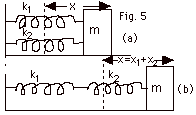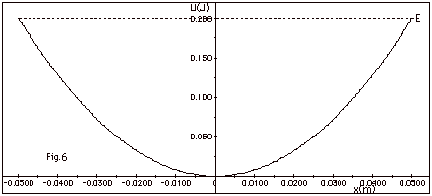|
Review - Simple Harmonic Motion
|
|
|
1.
|
Imagine that you videotape the motion
of a mass attached to a spring and measure the displacement
x from the equilibrium position as a function of time t. When
you plot x versus t, you get a graph resembling Fig. 1a below.
The mathematical expression for the curve of Fig. 1a is:
x(t) = xm cos 2pt/T
(Equation
#1)
where xm is the amplitude of the motion, the maximum
displacement from the equilibrium position and T is the period,
the time for one complete oscillation. From Fig. 1a, find
the amplitude and the period of the motion.
|
|
 |
|
2.
|
Fig. 1b above is a plot of the velocity
v as a function of the time t. You find v from the slope dx/dt
of x versus t.
v(t) = (-2p/T)(xm sin
2pt/T) (Equation
2)
Find (a) from Equation 2, an expression for the maximum velocity
in symbols, and (b) from Fig. 1b, the magnitude of the maximum
velocity.
|
|
|
3.
|
Fig. 1c above is a plot of acceleration
a as a function of the time t. You find a from the slope dv/dt
of v versus t.
a(t) = -(2p/T )2 (xm
cos 2pt/T) (Equation
3)
Find (a) from Equation 3, (i) an expression for the maximum
acceleration, and (ii) -a(t)/x(t) in symbols, and (b) from
Fig. 1c the magnitude of the maximum acceleration.
|
|
|
4.
|
When the force on an object is directly
proportional to, and in the opposite direction of, the displacement,
the motion of the object is simple harmonic.
(a) Show that the motion of a mass attached to a stretched
spring is simple harmonic. (b) Find the ratio, -acceleration/displacement.
|
|
|
5.
|
Equate the expression found for -a/x
in Part b of Problem 4 to that found in Problem 3a(ii) to
find the period T of the motion for the mass-spring system.
|
|
|
6.
|
For x(t) = xm cos 2pt/T,
xo = xm when t = 0. v(t) = -2p/T(xm
sin 2pt/T), vo = 0 when
t = 0. In other words for this equation, the initial position
xo equals the maximum displacement xm
from the equilibrium position and the initial velocity vo
= 0. You can provide for xo = xm
and vo = 0 by writing x(t) =
A cos (2pt/t
+ f), (Equation
#1), where f is
the phase constant that depends on xo and vo.
Show that Eq. 1 guarantees the definition of (a) the
period T and (b) the amplitude xm. (c) Find
xo and vo when f
= -p/2 and describe where the mass is initially and
how it is moving.
|
|
|
7.
|
Given x(t) = xm cos (2pt/T
+ f). Sketch x(t) for
f equal to (a) 0, (b)
-p/2, and
(c) -p. Sketch v(t)
for f equal to (d) 0,
(e) -p/2, and (f) -p.
(g) What is the usefulness of f ?
|
|
|
8.
|
When a 0.50 kg-object is attached to
a vertically supported spring, it stretches 0.10 m from the
equilibrium position. Find k for the spring.
|
|
|
9.
|
A massless spring of constant k is hung
vertically and not extended. A mass m is attached to the spring
and it stretches a distance xo. (a) Find
xo in terms of k, m and g. Now the spring is pulled
down an additional distance x. (b) Write Newton’s
second law for total extension (x + xo), and (c)
find the frequency of the motion when the spring is released.
|
|
|
10.
|
A pendulum bob of mass m attached to
a string of length L vibrates back and forth along a circular
arc. (a) Draw an isolation diagram for the bob and show all
the forces acting on it. (b) Write Newton's second law of
motion for the component of the force tangent to the path.
(c) For small angles, the horizontal displacement x is approximately
equal to the displacement along the arc s (Fig. 2 below).
Show that for small displacements, the pendulum vibrates with
simple harmonic motion. Find the frequency of its motion.
|
|
 |
|
11.
|
Given x(t) = xm cos 2pt/T
for a spring with constant k and attached mass m sketch as
a function of t, (a) the displacement x, (b) the velocity
v, (c) the acceleration, (d) the potential energy, (e) the
kinetic energy, and (f) the total energy.
|
|
|
12.
|
An object with mass m = 0.60 kg attached
to a spring with k = 10 N/m vibrates back and forth along
a horizontal frictionless surface. If the amplitude of the
motion is 0.050 m, what is the velocity of the object when
it is 0.010 m from the equilibrium position.
|
|
|
13.
|
Given x(t) = 0.01 m cos (0.02ps-1
t - p/2). Find (a) the amplitude,
(b) the period, (c) the frequency, and (d) the initial phase
of the motion.
|
|
|
14.
|
A particle is executing simple harmonic
motion. The displacement x as a function of time t is shown
in Fig. 3 below. Find (a) the period, (b) amplitude,
(c) equation of motion, (d) maximum velocity and (e) maximum
acceleration.
|
|

|
|
15.
|
A pendulum bob swings a total distance
of 4.0 cm from end to end and reaches a speed of 10 cm/s at
the midpoint. Find the period of oscillation.
|
|
|
16.
|
The motion of a particle is given by
x(t) = 4.0 cm cos (pt
s-1 - p/6).
Find the velocity of the particle when x = 2.0 cm.
|
|
|
17.
|
A pendulum consists of a rod of mass
m1 and a point mass m2
(Fig. 4 below). Find (a) the torque and moment of inertia
about the pivot point, (b) d2Q/dt2
in terms of t and I and (c) the
period for small oscillations in terms of m1,
m2, L, and g.
|
|

|
|
18
|
In Fig. 5a below, two springs of spring
constants k1 and k2 are connected in
parallel. In Fig. 5b below, they are connected in series.
Find the frequencies of the systems for (a) Fig. 5a and (b)
Fig. 5b.
|
|
 |
|
19.
|
A massless spring with spring constant
k = 10.0 N/m is attached to an object of mass m = 0.300 kg.
One third of the spring is cut off. What is the frequency
of the oscillations when the "new" spring-mass is
set into motion?
|
|
|
20.
|
Figure 6 below is a plot of the potential
energy of a mass-spring system. The total mechanical energy
E of the system = 0.200 J. Find (a) the potential energy U
and (b) the kinetic energy K at x = 0.025 m. Find (c) the
spring constant k and (d) the speed of the particle when x
= 0.025 given that the mass of the object m = 0.30 kg. Find
(e) the amplitude of the motion and (f) the maximum velocity
of the object.
|
|

|